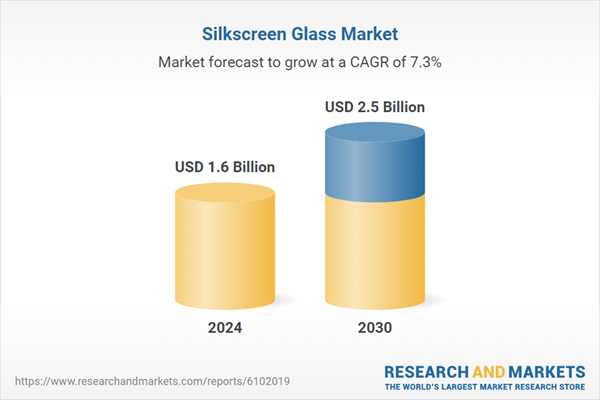Speak directly to the analyst to clarify any post sales queries you may have.
10% Free customizationThis report comes with 10% free customization, enabling you to add data that meets your specific business needs.
Meanwhile, in the automotive segment, silkscreen glass is being utilized in windshields, sunroofs, and rear windows for enhanced UV protection, branding, and design versatility. A shift in consumer preferences toward customized, visually appealing solutions is also boosting demand. Technological progress - including digital and hybrid printing, eco-friendly ceramic inks, and improved curing - has enhanced durability, precision, and sustainability. Additionally, emerging uses in electronics and healthcare are expanding the application landscape of silkscreen glass beyond traditional domains.
Key Market Drivers
Expanding Construction and Infrastructure Development Worldwide
The construction industry's global growth is a major catalyst for the silkscreen glass market. Rapid urban development and modernization, especially in emerging regions such as Asia-Pacific, the Middle East, and Africa, are increasing the demand for architectural glass that combines aesthetic value with functional benefits. Silkscreen glass is favored in building projects for its ability to deliver customized patterns, textures, and colors, aligning with contemporary architectural styles.It is widely applied in curtain walls, facades, partitions, doors, balustrades, canopies, and decorative interiors. As sustainability and energy efficiency gain traction, silkscreen glass is increasingly used for its solar control and glare reduction capabilities. These properties support green building initiatives and help enhance natural lighting in structures. Regulatory support for environmentally friendly construction materials has further accelerated the use of recyclable and energy-efficient silkscreen glass in modern infrastructure projects.
Key Market Challenges
High Production Costs and Complex Manufacturing Processes
The high cost and complexity of producing silkscreen glass represent a key challenge for market growth. Manufacturing involves multiple precise steps - such as surface preparation, stencil design, ink application, and high-temperature curing - requiring specialized equipment, skilled technicians, and rigorous quality control. This intricate process raises operational costs and increases the risk of defects or material wastage.Additionally, the use of ceramic inks for automotive or exterior applications necessitates tempering, which consumes significant energy and adds to production expenses. Compared to digital printing technologies, silkscreen printing also incurs higher setup costs, particularly for small-batch or customized orders, making it less accessible for cost-sensitive projects. These cost dynamics limit the widespread adoption of silkscreen glass to high-end or large-scale construction and industrial uses.
Key Market Trends
Growing Demand for Customization and Aesthetic Integration in Architecture and Interiors
A rising trend in the silkscreen glass market is the increasing demand for visually distinctive and customizable design elements in architectural projects. Designers and architects are prioritizing materials that combine performance with aesthetic flexibility. Silkscreen glass enables intricate patterns, gradients, logos, and even photographic designs, making it ideal for enhancing both exterior and interior spaces in residential, commercial, and institutional settings. As the desire for personalized living and working environments grows, screen-printed glass is gaining popularity for its durability and resistance to UV rays, weather, and abrasion - especially when using ceramic inks.The ability to permanently embed designs during the glass tempering process makes it suitable for exterior façades and high-traffic interior areas. Digital tools have streamlined the design process, allowing for pre-production simulations that reduce trial costs. In sectors like hospitality and retail, there is growing interest in glass elements that reflect branding and cultural motifs. Additionally, designers are incorporating silkscreen patterns not only for decoration but also to manage solar gain and glare, aligning with sustainability and energy-efficiency objectives.
Key Market Players
- AGC Inc. (Asahi Glass Company)
- Saint-Gobain S.A.
- Guardian Industries
- NSG Group (Nippon Sheet Glass Co., Ltd.)
- Şişecam Group
- Vitro Architectural Glass
- Pilkington Group Limited
- Fenzi Group SpA
Report Scope:
In this report, the Global Silkscreen Glass Market has been segmented into the following categories, in addition to the industry trends which have also been detailed below:Silkscreen Glass Market, By Product:
- Low-e
- Special
- Others
Silkscreen Glass Market, By Application:
- Residential Buildings
- Commercial Buildings
- Industrial Buildings
Silkscreen Glass Market, By Region:
- North America
- United States
- Canada
- Mexico
- Europe
- Germany
- France
- United Kingdom
- Italy
- Spain
- Asia Pacific
- China
- India
- Japan
- South Korea
- Australia
- South America
- Brazil
- Colombia
- Argentina
- Middle East & Africa
- Saudi Arabia
- UAE
- South Africa
Competitive Landscape
Company Profiles: Detailed analysis of the major companies present in the Global Silkscreen Glass Market.Available Customizations:
With the given market data, the publisher offers customizations according to a company's specific needs. The following customization options are available for the report.Company Information
- Detailed analysis and profiling of additional market players (up to five).
This product will be delivered within 1-3 business days.
Table of Contents
Companies Mentioned
- AGC Inc. (Asahi Glass Company)
- Saint-Gobain S.A.
- Guardian Industries
- NSG Group (Nippon Sheet Glass Co., Ltd.)
- Şişecam Group
- Vitro Architectural Glass
- Pilkington Group Limited
- Fenzi Group SpA
Table Information
| Report Attribute | Details |
|---|---|
| No. of Pages | 188 |
| Published | June 2025 |
| Forecast Period | 2024 - 2030 |
| Estimated Market Value ( USD | $ 1.6 Billion |
| Forecasted Market Value ( USD | $ 2.5 Billion |
| Compound Annual Growth Rate | 7.3% |
| Regions Covered | Global |
| No. of Companies Mentioned | 8 |









